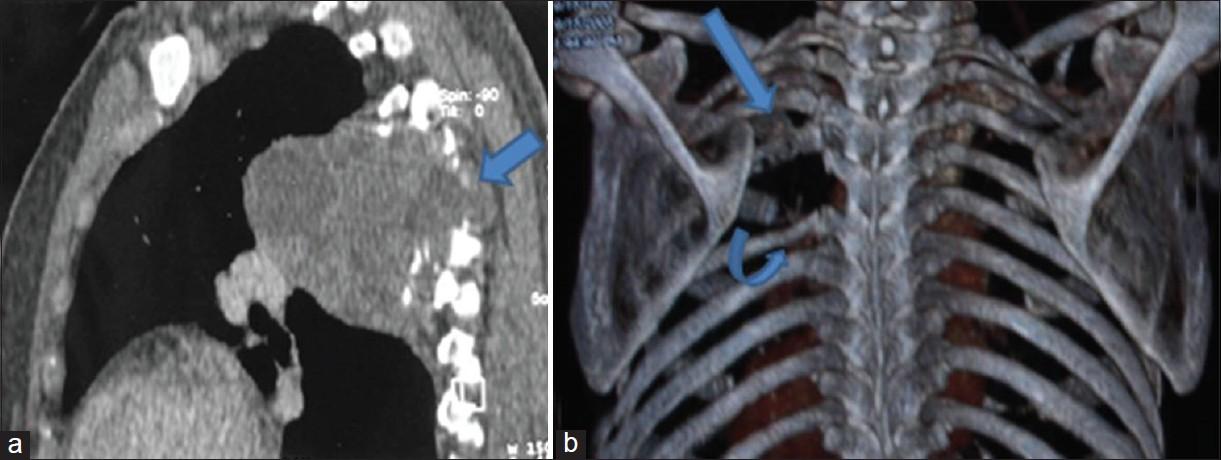Translate this page into:
Unusual Mediastinal Dumbbell Tumor Mimicking an Aggressive Malignancy
Address for correspondence: Dr. Bhawna Satija, B-1 / 57, Paschim Vihar, New Delhi - 110 063, India. E-mail: satijabhawna@yahoo.com
-
Received: ,
Accepted: ,
This is an open-access article distributed under the terms of the Creative Commons Attribution License, which permits unrestricted use, distribution, and reproduction in any medium, provided the original author and source are credited.
This article was originally published by Medknow Publications & Media Pvt Ltd and was migrated to Scientific Scholar after the change of Publisher.
Abstract
Hydatid cyst is known to affect all possible anatomical locations of the human body. However, the mediastinal localization is extremely rare. This benign, commonly asymptomatic and incidentally detected disease, at times may simulate an aggressive malignancy by its potential to cause osseous destruction and intraspinal extension. A young female, farmer by occupation, presented with complaints of left chest pain and monoparesis of the left lower limb. Radiograph followed by computed tomography (CT) of the chest demonstrated a cystic mass within the posterior mediastinum, eroding and scalloping overlying ribs and extending into the spinal canal by causing destruction of adjoining vertebra, and assuming a dumbbell shape. The serology was positive for echinococcosis. The patient underwent surgery and the postoperative histopathology confirmed the diagnosis of hydatid cyst. The patient recovered with no complications or recurrence. Hydatid cyst should always be considered in the differential diagnosis of mediastinal cystic lesions, however aggressive the lessions may appear.
Keywords
Dumbbell
echinococcosis
hydatid cyst
intraspinal
mediastinal
INTRODUCTION

Hydatid disease is a parasitic disease caused by the larvae of a tapeworm belonging to the Genus Echinococcus. It can affect any part of the human body, the liver and the lung being the most frequently involved organs. An intra-thoracic but extra-pulmonary location is very rare, representing less than 0.1% of all cases. Mediastinal localization is exceptional with less than 150 cases reported in the literature so far. We report an even rarer presentation of hydatid cyst in the posterior mediastinum causing erosion of the overlying ribs and adjoining vertebra with extension into the spinal canal, assuming a dumbbell shape, and simulating an aggressive malignancy. There have been less than 10 cases of hydatid disease with mediastinal localization and intraspinal extension reported until date. This case report emphasizes that a differential diagnosis of hydatid should be considered for a mediastinal cystic mass, however, aggressive it may appear, clinically or radiologically.
CASE REPORT
A 22-year-old female, farmer by occupation, presented with complaints of chest pain and progressive weakness of left lower limb that had persisted for 3 months. There was no history of fever, weight loss, or trauma. The general physical examination was unremarkable. Respiratory system examination revealed dullness on percussion and tenderness in left infraclavicular, suprascapular, and interscapular regions. The routine laboratory investigations were normal.
Radiographs of chest, performed in posterior-anterior (PA) and lateral projections, demonstrated well-defined homogenous soft tissue opacity in the posterior mediastinum. There was erosion of the 4th rib posteriorly, scalloping of superior margin of 5th rib, and widened fourth intercostal space [Figure 1a and b]. Contrast enhanced computed tomography (CT) of the thorax revealed a well-defined, multiloculated cystic mass in the left paravertebral space, extending into the spinal canal by causing erosion of the adjoining pedicle and lamina of fourth thoracic vertebra. There was erosion of the overlying 4th rib with scalloping of the 5th rib and widened intervening intercostal space [Figures 2 and 3].

- Chest X-ray (a) posterior anterior (PA) and (b) lateral views show well-defined homogeneous soft tissue opacity within posterior mediastinum, causing erosion of the 4th rib posteriorly, scalloping of the superior margin of the 5th rib and widening of the 4th intercostal space (arrow).

- Contrast enhanced computed tomography (CT) thorax in (a) mediastinal and (b) lung windows show multiloculated cystic lesion in left paravertebral space, causing erosion of pedicle and lamina of the 4th dorsal vertebra, with intraspinal extension (blue arrow). The 4th rib is eroded (red arrow). Lung parenchyma is extrinsically compressed, unremarkable otherwise (black arrow).

- (a) Three dimensional sagittal multiplanar reformation shows posterior mediastinal mass causing destruction of adjoining vertebra (arrow) with intraspinal extension. (b) Volume rendered coronal image shows erosion of the 4th rib (straight arrow) and scalloping of the 5th rib (curved arrow) with widened 4th intercostal space.
Based on the imaging findings, the possible differential diagnosis included neurogenic tumors, aggressive malignant masses like round cell tumors (Ewing's sarcoma, primitive neuroectodermal tumors, and others), lymphoma, or metastasis. Since the mass was predominantly cystic with multiloculated appearance and considering the occupation of the patient, hydatid cyst was also considered a possible differential diagnosis.
The serological test with enzyme linked immunosorbant assay (ELISA) was positive for echinococcosis, thus suggesting hydatid cyst as a possible etiology. The patient was operated and the cystic mass along with the involved 4th rib were completely excised. The diagnosis was confirmed macroscopically preoperatively and by histopathological studies postoperatively. Postoperative recovery was uneventful and the patient was discharged and put on adjuvant chemotherapy with mebendazole for 2 years. The patient was monitored with routine follow-ups for 5 years with no evidence of recurrence.
DISCUSSION
Hydatid disease is a zoonosis caused by the parasite Echinococcus. There are two species of Echinococcus—Echinococcus granulosus and Echinococcus multilocularis. E. granulosus is most frequently encountered in hydatid disease in humans. Hydatid disease continues to be a major health problem in underdeveloped areas where animal husbandry is common and no veterinary control exists. It is endemic in parts of South America, Mediterranean regions, the Middle East, Africa, and Australia. Dogs or other carnivores are definitive hosts. Sheep and other ruminants are intermediate hosts. Humans are secondary hosts and are infected by the ingestion of food or water contaminated by eggs of these parasites.
In humans, the liver is the most frequent site of involvement followed by the lungs. Other sites in decreasing frequency include peritoneum, kidney, brain, mediastinum, heart, bone, soft tissues, spinal cord, spleen, pleura, adrenal glands, bladder, ovary, scrotum, and thyroid gland.
Mediastinal hydatid cysts are very rare, accounting for less than 0.1% of all cases and less than 1% of thoracic involvement. These occur more frequently in the posterior mediastinum.[1] The patients may remain asymptomatic, the lesion being discovered incidentally on a routine chest radiograph. The patients may present with non-specific symptoms of chest pain, cough, and dyspnoea. These symptoms may be produced as a result of involvement of neighboring structures and other etiologies like hemoptysis, superior vena cava syndrome, phrenic or recurrent laryngeal nerve compression, vertebral destruction with intraspinal extension and neurological symptoms, and Bernard–Horner syndrome.[2] The complications of mediastinal hydatid cyst can be significant and include rupture into the mediastinum, pleural cavity and right ventricle, cysto-aortic fistula with possible embolization, and infection and compression of vital structures.
Posterior mediastinal hydatid cyst with intraspinal extension is an extremely rare entity, with less than 10 similar cases reported in the literature till date.[34] Such masses with both intraspinal and extraspinal components assume a dumbbell shape.[5] Though the most common cause of dumbbell masses is neurogenic tumor, a large variety of unusual lesions may produce similar picture. These include neoplastic lesions such as benign/malignant peripheral nerve sheath tumors, plasmacytoma, chondrosarcoma, chondroid chordoma, superior sulcus tumor, metastasis, and nonneoplastic lesions such as infectious process (tuberculosis, hydatid cyst), aneurysmal bone cyst, synovial cyst, traumatic pseudomeningocele, arachnoid cyst, vertebral artery tortuosity, and hemangiomas. Paravertebral masses with vertebral destruction and intraspinal extension have been described as spinal hydatids by some authors,[6] and belong to Group 5, paravertebral hydatid disease, according to the Braithwaite and Lee's classification.[7]
Mediastinal echinococcosis is clinically and radiologically indistinguishable from other mediastinal cystic lesions. The differential diagnosis of posterior mediastinal cystic lesions includes bronchogenic cysts, cystic lymphangioma, enteric cyst, and neurogenic tumors. Presence of a posterior mediastinal mass with rib and vertebral destruction and intraspinal extension can raise the possibility of aggressive malignant masses like round cell tumor (Ewing's sarcoma, primitive neuroectodermal tumor, etc.), lymphoma, metastasis, or neurogenic tumor.[8]
Serological tests can often be negative, especially when the cyst is intact and uncomplicated. In suspected cases, aspiration cytology under imaging guidance is considered the procedure of choice for establishing the diagnosis.[9]
Radiological imaging consists of chest radiograph and CT of the thorax. CT defines the cystic nature of the mass and delineates its exact anatomical relations. Though presence of multiloculated appearance and calcification may suggest the diagnosis, there is no pathognomonic sign of hydatid cyst on CT. Magnetic resonance imaging is indicated in defining the intraspinal extension, especially when patients present with neurological signs.
The Gold Standard for treatment of mediastinal hydatid cyst is radical removal of the germinative membrane and pericyst.[10] If total excision is not possible due to invasion of vital structures, partial pericystectomy after removal of germinative membrane can be performed. It has been proposed that better results are obtained by combining surgical procedure with antihelminthic therapy postoperatively. World Health Organization recommends adjuvant chemotherapy with mebendazole or albendazole for 2 years postoperatively.
CONCLUSION
To conclude, hydatid cyst should always be considered in the differential diagnosis of mediastinal cystic lesions, especially in endemic areas, even when the lesion appears aggressive clinically and on imaging.
Available FREE in open access from: http://www.clinicalimagingscience.org/text.asp?2012/2/1/67/103057
Source of Support: Nil
Conflict of Interest: None declared.
REFERENCES
- Hydatid cyst: An unusual disease of the mediastinum. Acta Chir Belg. 2001;101:283-6.
- [Google Scholar]
- Primary hydatid cyst of the posterior mediastinum. Asian Cardiovasc Thorac Ann. 2007;15:e60-2.
- [Google Scholar]
- Posterior mediastinal paravertebral hydatid cyst presenting as spinal compression. A case report. Clin Neurol Neurosurg. 1990;92:149-51.
- [Google Scholar]
- Rare location of a hydatid cyst- in the upper mediastinum migrating into the spinal channel. Rev Med Chir Soc Med Nat Iasi. 2001;105:573-5.
- [Google Scholar]
- Unusual dumbbell tumours of the mediastinum and thoracic spine. J Clin Neurosci. 2006;13:958-62.
- [Google Scholar]
- Dumbbell hydatid cyst of the spine: Case report and review of the literature. Spine (Phila Pa 1976). 2000;25:1296-9.
- [Google Scholar]
- Ultrasound guided fine-needle aspiration cytology: Diagnosis of hydatid disease of the abdomen and thorax. Diagn Cytopathol. 1995;12:173-6.
- [Google Scholar]






